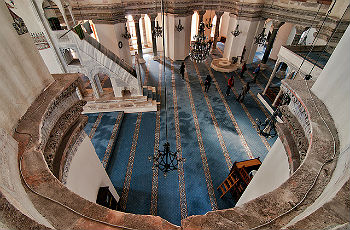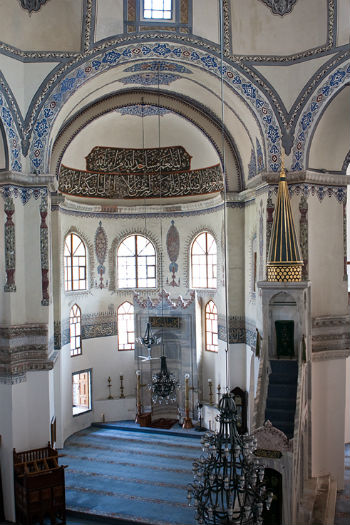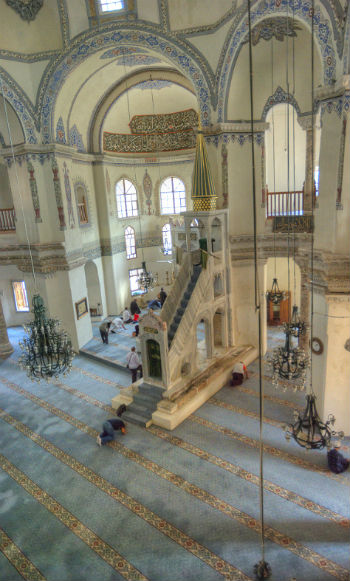Begun in 527 by Emperor Justinian, the Church of Saints Sergius and Bacchus in Istanbul was an early experiment in Byzantine architecture, with a large central dome supported by an octagonal base. The church is now a mosque called Küçük Ayasofya Camii (Little Hagia Sophia Mosque), named for its resemblance to the much larger Hagia Sophia built a few years later.
History
Saints Sergius and Bacchus are Christian Roman soldiers who were martyred in Syria in 303 AD. They became the patron saints of soldiers and their cult was very popular in Syria and beyond.
The Byzantine Emperor Justinian (r. 527-65) was among the saints’ devotees. According to legend, when Justinian was a young man he was condemned to death for plotting against Emperor Anastasius. But Sergius and Bacchus appeared to the emperor in a dream, convincing him to release Justinian.
Justinian began construction on a church dedicated to Sts Sergius and Bacchus immediately after becoming emperor himself in 527 AD; it was completed by 536 AD. The architect was Anthemius of Tralles, a mathematician and the author of a book on burning mirrors, the Paradoxographia. The chosen site was just inside the sea walls west of the Hormisdas Palace (where Justinian lived before ascending the throne), next to the Hippodrome.
The church was connected to a three-aisled basilica dedicated to St. Peter and St. Paul, which Justinian had begun to build in 519. None of it survives today. The Church of Sts. Sergius and Bacchus was built on an octagonal floor plan with a central dome, which inspired the design of the great Hagia Sophia, begun just a few years later in 532. The earlier church was therefore dubbed the Little Ayasofya.
The church was converted into a mosque in the 16th century under Sultan Beyazit II and remains an active mosque today.
What to See
Church of the Saints Sergius and Bacchus is located on the south side of Istanbul next to the Hippodrome; a railway line (near Sirkeci Station) runs between the south wall of the church and sea wall.
The Church of the Saints Sergius and Bacchus interior is decorated and furnished as a mosque, with Arabic calligraphy and designs in blue painted on white walls. Originally, the walls and vault would have been completely covered in golden mosaics, like those that survive from this period in Ravenna, and probably frescoes as well.
The architecture of the building, however, survives fully intact from the Byzantine era. So too does the Greek dedicatory inscription around the central nave:
A fine view of the interior can be had from the gallery stairs are to the right of the entrance.











A little off the beaten track this camii gives its name to the neighbourhood in which it is situated. You may find you can only get into it at prayer time but not a problem is you stay discreetly at the back
The mosque retains the shape of the original Justinian church and there is an octagonal baptistery beside it, although the interior orientation has been changed a bit to align with the mihrab and the minbar where the iman delivers the Friday sermon. The interior is a total aesthetic delight, with every detail.
The recently restored building and grounds is well worth the visit. The interior contains numerous inscriptions and the sheer beauty of the space is charming. The power of God is on display in this wonderful Byzantine monument.
My second time here, still such an awesome interior. The various mosaics are amazing. Well worth a visit.
Ayasofya is a precious thing, here traditions and religions, races and people are mixed together like the pieces of mosaics I saw there, creating a unique rainbow of colours and feelings.
An off the beaten track attraction, it's not a must see on a short visit but it's worth popping in for the classic sixth century architecture. Unlike in a lot of other mosques visitors can walk around the upper galleries, affording a good view of the whole building.
I can't believe I've been here so many times and didn't go visit this gem. It is a working mosque, so be sure to cover up ladies. This small mosque is so beautiful and serene inside. I went just before prayer time, so only one many was inside praying. Very peaceful with fantastic architectural features.
Hagia Sofia and Sultanahamet get all the glory as the two large and imposing mosques located the heart of historic Istanbul. However, you would be doing yourself a disfavour if you didn't take ten minutes to walk down to what is know as Little Hagia Sofia mosque. It is often said it is a miniature version of Hagia Sofia.
This little church converted to mosque is a real jewel. The carved friezes atop the colonnades, the intimate feel to it and its historic importance make it a real must. The courtyard also houses a nice tearoom.
This place is beautiful – a 6th century Byzantine church (built by Justinian prior to the construction of the grand Ayasofya) that is now a mosque. There seem to be few visitors, so you can enter and roam pretty freely. It is an oasis of quiet in the craziness of the old city.